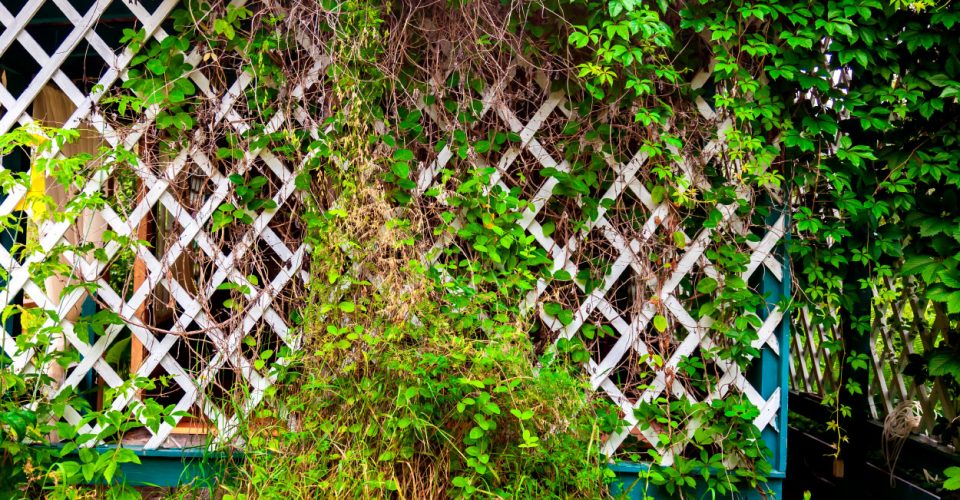How To Stop Ivy Growing Through Your Fence
There are two types of ivy that are native to the UK. One variety, Hibernica, is not a climbing plant, but instead grows across the ground and provides food and shelter to some of our valued organisms.
The other, however, is a climber that can wreak havoc on your fence. If you’ve noticed this vining ivy taking over your yard, you’re probably wondering what to do about it.
A common complaint is that ivy doesn’t just overtake fences, but actually grows through them. If you want to know how to stop ivy growing through your fence, you’re in the right place.
Read on to learn how to get rid of ivy that is destroying your fence.

How to Stop Ivy Growing Through Your Fence
Some homeowners may enjoy the look of ivy or the wildlife it brings to their backyard. You may determine that you don’t want to kill your ivy plant entirely, but instead want to keep it from growing through the slats of your fence or becoming too heavy, which can cause expensive structural damage.
If this is the case, you’ll need to practice regular ivy maintenance. To do so, you will need gardening gloves and shears. You may also want to grab a spray bottle of vinegar and water to make the job a bit easier.
The goal is to thin the ivy plant by removing select branches, particularly those that are starting to grow through the slats or wires of your fence. Use your shears to clip the strands that you wish to remove from the main branch, wearing your gloves to avoid irritation when you remove the severed strand. If the strands are stuck tight, spray them with your vinegar solution and wait a day or two until they start to wilt and turn brown and they’ll be much easier to peel away from your fence.
What If the Ivy Is Growing in a Neighbour’s Yard?
What if the ivy that’s troubling you isn’t growing from an ivy plant in your own yard? If your neighbour’s ivy is taking over your fence, begin the process with a conversation. The best prevention would start on their side of the fence, where they could remove the plant or practise the steps we’ve mentioned above.
If your neighbour is attached to their ivy plant and unwilling to help, you’ll need to clip away the vines that have grown through the fence and into your side of the yard on a regular basis. This may seem frustrating, but it’s often the best solution when your neighbour does not want to get involved.
How to Kill Ivy Plants Around Your Fence
If regular garden ivy maintenance is not your cup of tea, you may want to consider killing the ivy plant, altogether. If the plant remains alive, it is likely to vine back up your fence even if you remove that system of branches. Let’s take a look at some of the steps to take when you want to get rid of the entire ivy plant.
Cutting the Main Branch
If you’re dealing with a massive ivy plant, the first step is to weaken the entire thing by severing the main branch. Follow the trails of vines to locate the “trunk” of the ivy plant and use shears or a hatchet to cut through it. This will stop the existing vines from continuing to grow and they’ll soon begin to die, making them easier to remove.
Should You Use Herbicides?
Some people wish to speed up the process of killing their ivy or may discover that they can’t locate the main branch. One option is to use a herbicide on the visible branches. Herbicides for ivy will include the chemical glyphosate, which is effective at killing unwanted plants but also comes with a few warnings, particularly for people who are pregnant or have existing health conditions.
Killing Ivy With Vinegar
If you aren’t interested in using herbicide, you can reach for ingredients found in your own home: white vinegar and water. As suggested above, the easiest way to use this mixture on ivy is to pour it into a spray bottle so that you can spray the leaves and vines with ease. Make sure that you saturate as much of the plant as you can and, in a few days’ time, you’ll find that those vines are dead and easy to peel away.
Killing Ivy With Boiling Water
Another chemical-free method is to douse ivy with boiling water, but we do encourage you to exercise caution. Never use boiling water on ivy when your pets or children are in the yard with you and be sure to avoid spilling or dumping the water on yourself. While boiling water is effective at killing ivy, it can also cause serious burns and may not be worth the risk.
Removing Ivy Roots
The reality is that ivy is one of the sturdiest plants in the UK and even if you cut the main branch and kill the existing vines, it can still grow back. If you can locate them, we do encourage you to remove the root system, as well. To do so, use a spade to dig into the earth surrounding the main branch until you locate all root systems, throwing them into a bin or compost pile.
Improve Your Home With Our Help
Ivy can look beautiful and, in some cases, improve the environment by providing food and shelter for other organisms. However, ivy can also cause structural damage and take over the plants you’re growing intentionally. Use this guide to learn how to stop ivy growing through your fence and to how to get rid of an unwanted ivy plant for good.
Looking for more ways to improve your home and property? We offer the best guides and tips for UK homeowners. Take a look at more of our exterior renovation guides to find new ways to improve your yard.

